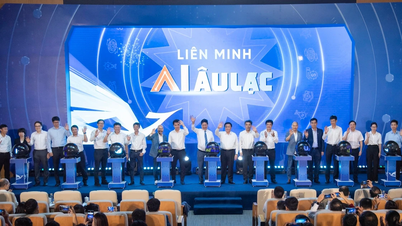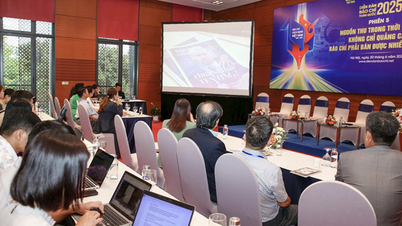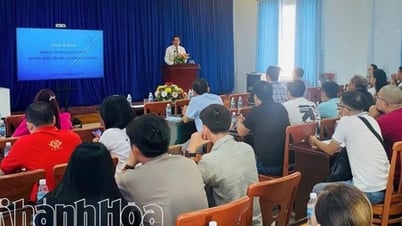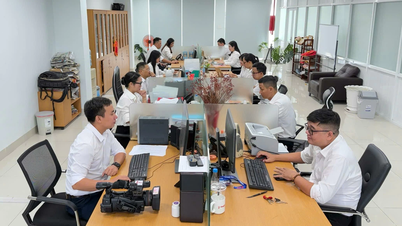As the global semiconductor (IC) industry is witnessing remarkable growth, Vietnam has set a goal of becoming an important link in this value chain.
Accordingly, the Forum “Digital Twin [Digital copy of a physical object] - Technology shaping the future of Vietnam's semiconductor industry” took place on June 12-13.
"The event was organized by the National Innovation Center (NIC) - Ministry of Finance in collaboration with Hanoi National University and Ho Chi Minh City, with the participation of technology group Lam Research (USA) and Dassault Systemes (France).
The highlight is that this event takes place within the framework of implementing Decision 1017/QD-TTg (September 21, 2024) on semiconductor human resource development to 2030 (vision 2045) and Decision 1018/QD-TTg of the same day on the Strategy for developing Vietnam's semiconductor industry to 2030–2050.
Promoting quality human resource ecosystem
The main objective of the forum is to build a cooperation platform between the State - School - Enterprise to promote a high-quality human resource ecosystem in the semiconductor industry. In which, universities and research institutes: have direct access to international simulations and training methods.
Domestic and foreign technology enterprises will participate in building industry-standard training standards and recruiting human resources based on actual needs. On that basis, students and young engineers will experience modern training technology, improve their practical skills, and prepare for the global semiconductor market.
At the discussion sessions, international and domestic experts shared global trends, practical lessons and demonstrated Digital Twin technology applied ineducation , research and chip manufacturing.
In particular, Lam Research Group introduced the solution “Semiverse Solutions” - a fully digital semiconductor manufacturing engineering simulation and training ecosystem, simulating steps (such as etch, deposition, clean, etc.). According to Mr. Andrew Goh, Vice President of Lam Research, Semiverse Solutions will expand semiconductor industry training opportunities, helping global human resources easily access realistic and intuitive virtual factory environments, thereby shortening the time to readiness for the workforce.
Meanwhile, Dassault Group introduced 3DExperience - an integrated system that simulates the entire design process to chip manufacturing, which has been successfully deployed at international universities such as Purdue (USA). Specifically, Mr. Lo Van Ba, Country Director of Dassault Systèmes in Vietnam, said that the digital twin technology (Virtual Twin) allows students and engineers to access laboratory-standard simulations remotely, contributing to narrowing the gap between theory and industrial practice.
Big challenge in human resources
According to experts, the semiconductor ecosystem in Vietnam recorded semiconductor revenue of nearly 17 billion USD in 2023 and is expected to have a compound annual growth rate of about 11% in the 2024–2027 period and reach 31 billion USD in 2027. In addition, the market size is 18.23–18.6 billion USD in 2024 while maintaining a growth rate of about 11–11.5%/year and the market is forecast to reach 16.64 billion USD in 2033 with a compound annual growth rate of about 9.3%.
Currently, Vietnam has about 6,000 semiconductor engineers working in more than 40 local enterprises. To meet development needs, the Government aims to train 30,000–50,000 engineers by 2030 according to Decision 1017. However, the demand for IT and engineering human resources is up to 150,000 people/year, while the supply only meets 40–50%. This poses a major challenge in training and developing high-quality human resources.
In terms of infrastructure, Saigon Hi-Tech Park (SHTP) has an area of 326 hectares (expanding to 913 hectares) and stands out for attracting big names (such as Intel, Nidec, Jabil, Air Liquide, Sonion...) with a workforce of up to tens of thousands of people.
Regarding investment, many international companies such as Amkor (USA) invested 1.6 billion USD in a chip packaging factory in Bac Ninh, Hana Micron (Korea) invested 930 million USD by 2026, Intel Corporation built one of the largest chip assembly and testing factories here.
Regionally, experts share that the Asia-Pacific semiconductor market will reach around US$505 billion in 2025, increasing to US$754 billion in 2030 at a CAGR of around 8.3%. In addition, chip manufacturing equipment in Asia is expected to increase from US$77.5 billion (2025) to US$147.9 billion (2033), at a CAGR of around 8.4%.
In particular, Taiwan (China) currently accounts for 50% of global chip manufacturing capacity. South Korea holds 17.7% of the global chip market share (2022), leading the memory segment (DRAM 70.5%, NAND 52.6%) and the government has committed to investing 470 billion USD in the next 23 years to build a national chip cluster. In addition, Japan dominates nearly 30% of the chip manufacturing equipment market share. Meanwhile, Malaysia is the leader in the global packaging and testing sector (nearly 13% market share).
Globally, semiconductor revenue in 2024 will reach 627.6 billion USD, up 19% compared to 2023 and is forecast to reach 697 billion USD in 2025. Accordingly, high-quality human resources are still a big challenge, specifically the United States will lack about 146,000 engineers/technical staff in 2029; South Korea will lack 56,000 people in 2031, Canada and Europe also face a similar situation.
At the event, Mr. Vu Quoc Huy, Director of NIC, said that through Decision 1017, the Government has set the goal of training 50,000 semiconductor engineers by 2030, focusing on IC design, packaging-testing, and manufacturing. In addition, Decision 1018 expands the strategy with the extensive participation of foreign-invested enterprises and domestic enterprises in the global supply chain, technical universities become centers for talent creation and development of innovation ecosystems with startups, investment funds, and high-tech research institutes.
“We hope the forum will be a breakthrough in the digital semiconductor training model. The advanced digital platform will help Vietnam develop internationally competitive human resources,” said Mr. Vu Quoc Huy.
On that basis, the leader of NIC respectfully invited universities of engineering, information technology, and electronics to test the digital twin platform in teaching. In addition, businesses participated in contributing to building standard programs and practical projects. A team of students and young engineers passionate about technology participated in technical sessions, practical experiences, and professional networking.
Prior to the forum, on June 11, the delegation of Lam Research Group and Dassault Systemes also had a working session with Deputy Minister of Finance Nguyen Duc Tam at the Ministry of Finance Headquarters. Here, the parties discussed the contents of strategic cooperation in the near future to promote the semiconductor ecosystem as well as develop the semiconductor human resource community in Vietnam.
Source: https://www.vietnamplus.vn/cong-nghe-nao-dinh-hinh-tuong-lai-nganh-cong-nghiep-ban-dan-viet-nam-post1043897.vnp







































![[Photo] The 9th Congress of the Party Committee of the Office of the President, term 2025-2030](https://vphoto.vietnam.vn/thumb/1200x675/vietnam/resource/IMAGE/2025/6/20/78e7f27e8c4b4edc8859f09572409ad3)























![[Maritime News] Wan Hai Lines invests $150 million to buy 48,000 containers](https://vphoto.vietnam.vn/thumb/402x226/vietnam/resource/IMAGE/2025/6/20/c945a62aff624b4bb5c25e67e9bcc1cb)












































Comment (0)